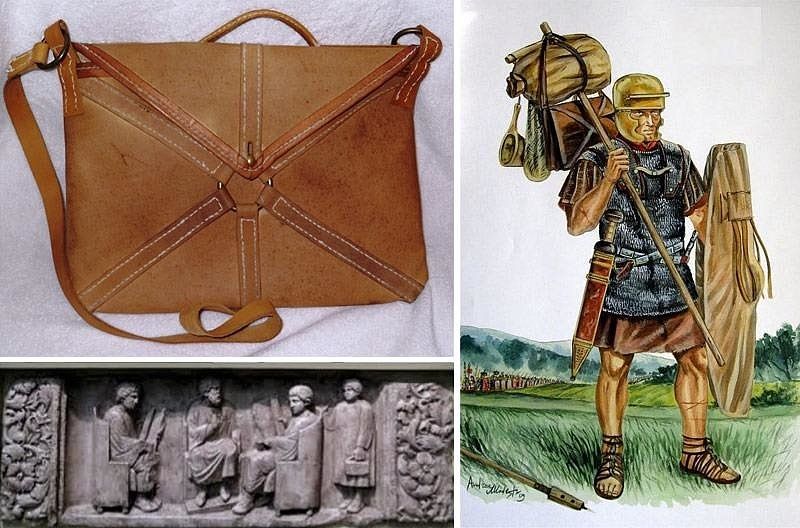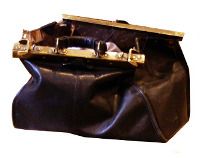 A stylish leather briefcase is an attribute of a business person, emphasizing his status and belonging to the caste of selected members of elite business.
A stylish leather briefcase is an attribute of a business person, emphasizing his status and belonging to the caste of selected members of elite business.
An elegant handbag for an elegant representative of the business community, stylized as a small briefcase that can accommodate folders with papers, cosmetics, and electronic devices of the modern world.
A colorful, roomy backpack is on the shoulders of a proud first-grader who is entering school for the first time.
Prototypes of a modern portfolio
 The items mentioned are a type of specialized bag, which we are already accustomed to calling a briefcase, and without which the appearance of a successful gentleman, business woman and schoolboy rushing to class now seems incomplete.
The items mentioned are a type of specialized bag, which we are already accustomed to calling a briefcase, and without which the appearance of a successful gentleman, business woman and schoolboy rushing to class now seems incomplete.
Human experience shows that the birth of a certain attribute is most often associated with the urgent need for the birth of this invention. The origin of the portfolio also has its own fascinating history.
Portfolio Definition
The term “briefcase” is a tandem of 2 French words: the verb porter and the noun feuille, in translation the phrase will sound like “to carry sheets”. By this designation, the French meant a rectangular bag with a clasp, designed for transporting important paper documents. Leather and its high-quality substitutes were considered the optimal raw material for the manufacture of briefcases in Europe, which quickly picked up the French initiative.
 Almost in parallel, the briefcase's colleague in the group of bags became the satchel; the word came into use from the German language, in which the name Ranzen was assigned to the shoulder bage, used not only for carrying folders and papers, but also for storing personal belongings. A comfortable satchel with straps on the back regularly accompanied servicemen on military campaigns and eased the lot of schoolchildren by distributing the heavy weight of textbooks and notebooks more evenly.
Almost in parallel, the briefcase's colleague in the group of bags became the satchel; the word came into use from the German language, in which the name Ranzen was assigned to the shoulder bage, used not only for carrying folders and papers, but also for storing personal belongings. A comfortable satchel with straps on the back regularly accompanied servicemen on military campaigns and eased the lot of schoolchildren by distributing the heavy weight of textbooks and notebooks more evenly.
When did the first briefcase appear?
The date of birth of the predecessor of this now fashionable accessory is considered to be the 19th century. In fact, an item useful for men was born much earlier. The palm in such an original discovery belongs to the omnipresent Roman Empire. Men's leather loculi with diagonal stripes of decoration cost the life of a calf or goat, the entire skin of which was used to make 1 copy.
The crown of creation were bronze rings that acted as fasteners. Roman loculi, which became the ancestors of modern products, appeared in the 1st-3rd centuries AD and are deservedly considered the first men's bags mentioned in ancient chronicles.

Roman loculus briefcase
Reference! The closest relative of the briefcase in the 20th century was the aristocrat diplomat, the basis of which was a body made of light and durable aluminum, and the surface could be made of leather or plastic.
 His birth in the business field was marked by:
His birth in the business field was marked by:
- Italian master Godillo, who invented the flat briefcase in 1826.
- Resident of Foggy Albion Bird, who proposed an oval shape for work bags in the 30s of the 18th century, which did not catch on in mass production due to problems with papers that mercilessly wrinkled inside the oval.
- Representative of the Americas Jeremy Stennig Having become the author of the idea of giving the briefcase a rectangular shape, the American went further in his endeavors and strengthened the briefcases with rigid ribs and equipped them with handles.
 The latest innovative discoveries have so inspired serial manufacturers of men's business props that various types of decor and useful improvements have been used. Now the briefcases were divided into several compartments and had internal pockets, including hidden and secret options.
The latest innovative discoveries have so inspired serial manufacturers of men's business props that various types of decor and useful improvements have been used. Now the briefcases were divided into several compartments and had internal pockets, including hidden and secret options.
The surface of intricate products was decorated with family signs in the form of coats of arms or initials of the owner and even an entire family family, embroidery, metal decorative fragments and even precious stones. The top line of the hit parade of exquisite briefcases was occupied by accessories made of young calf leather with locks and a set of small keys in addition.
 Owners of luxury leather goods should not forget that the keys to the lock to the briefcase are an important auxiliary element. The history of this accessory for businessmen knows many cases when important negotiations were disrupted due to the loss of the key to a business bag with papers fundamental for concluding a contract.
Owners of luxury leather goods should not forget that the keys to the lock to the briefcase are an important auxiliary element. The history of this accessory for businessmen knows many cases when important negotiations were disrupted due to the loss of the key to a business bag with papers fundamental for concluding a contract.
Reference! At the beginning of the 21st century, Estonian Defense Minister Margus Hansson's passion for expensive accessories cost him his ministerial position. The business bag of a government official attracted the attention of thieves, who stole a briefcase from a military official with a folder of documents of national importance.
 A distant relative of the legion of assorted briefcases a little later became a certain hybrid of a bag and a satchel, called a backpack. The fashion for backpacks was quickly picked up by the fair sex, raising the whimsical design of these products to unprecedented heights.
A distant relative of the legion of assorted briefcases a little later became a certain hybrid of a bag and a satchel, called a backpack. The fashion for backpacks was quickly picked up by the fair sex, raising the whimsical design of these products to unprecedented heights.
 Athletes, active tourists and, of course, schoolchildren began to use backpacks, who gladly exchanged heavy backpacks for a new type of training bag with shoulder straps. Another brother of the man's bag is the travel bag; this item was an indispensable travel companion for successful lawyers, practicing doctors, going out on private calls and clerks of all stripes who wanted to add grandeur to their place on the hierarchical ladder of government positions.
Athletes, active tourists and, of course, schoolchildren began to use backpacks, who gladly exchanged heavy backpacks for a new type of training bag with shoulder straps. Another brother of the man's bag is the travel bag; this item was an indispensable travel companion for successful lawyers, practicing doctors, going out on private calls and clerks of all stripes who wanted to add grandeur to their place on the hierarchical ladder of government positions.
What materials are briefcases made from?
Since the days of the Roman loculi, little has changed in the selection of materials for the manufacture of quality products. The favorite in this direction has been and remains genuine leather and its analogues, the rest of the raw materials represent the following collection:
- Representative of the cotton fabric order - bookbinding calico.
- Complex polymer vinyl, better known to the general public by the abbreviation PVC - plastic polyvinyl chloride.
- Animal fur for the interior upholstery of expensive leather creations.
- Multi-colored variety of artificial leather - dermatitis, who painted the briefcases in a wide range of bright colors.
- Cotton and synthetic fabrics with special protective impregnations from sunlight and excess moisture.


Schoolbag
Modern briefcase
The popularity of briefcases, which make the life of a modern person easier, is not falling at all and is only gaining new momentum.
 There haven't been many major innovations in the production of useful products.
There haven't been many major innovations in the production of useful products.
 A breakthrough in reducing the weight of briefcases should be an electronic product, more like a compact mini-computer with a pen, which you can take with you to a business meeting, on a trip, or to classes at an educational institution.
A breakthrough in reducing the weight of briefcases should be an electronic product, more like a compact mini-computer with a pen, which you can take with you to a business meeting, on a trip, or to classes at an educational institution.
 All papers in such a briefcase will become redundant, information will be collected on electronic media, scientists suggest that the weight of such a bag will not exceed 1 kg.
All papers in such a briefcase will become redundant, information will be collected on electronic media, scientists suggest that the weight of such a bag will not exceed 1 kg.
In the meantime, briefcases are used everywhere in the form familiar to everyone. In 2004, in Yalta, a funny bronze monument was even erected to the favorite accessory. and gave it the name “Zhvanetsky’s Portfolio”.


 0
0






Interesting article. Well written. It’s just not clear what kind of material this is - dermatitis. If I'm not mistaken, dermatitis is a skin disease. And the material is leatherette.